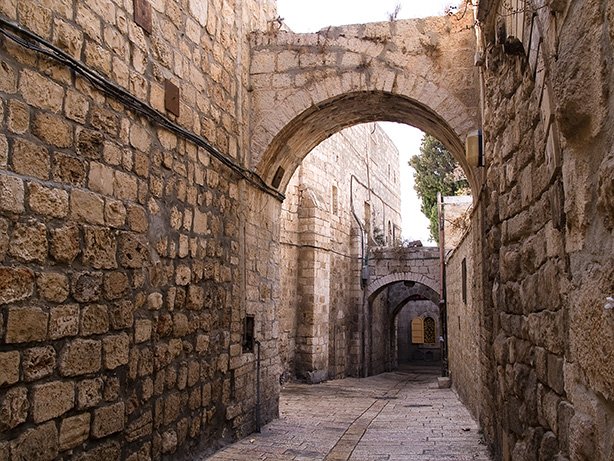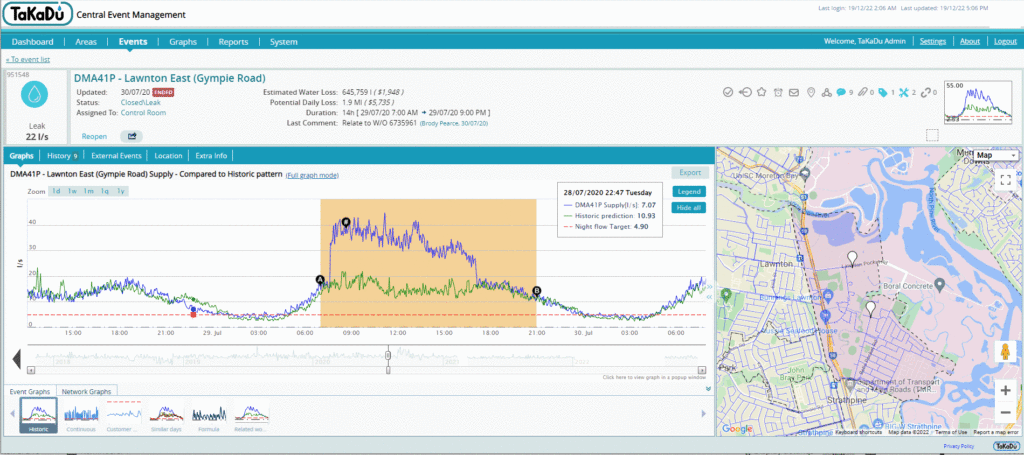
Old City of Jerusalem Presents some Unique Challenges for Leak Detection
Every single TaKaDu customer has a unique story – varied types of service areas, different regulatory environments, and specific challenges. But perhaps one of the most unique is the story of Hagihon, the water and wastewater utility for the Jerusalem area of Israel.
Some water utilities cover historical areas, where there are protected structures that may be several hundred years old. Managing a water network in such a place can be challenging. But imagine what it’s like managing water infrastructure in a city where every single inch of ground is historical, where there are structures that are thousands of years old and sacred sites for several religions, and where the buildings are so densely packed that no heavy machinery can be brought in.
The Hagihon water utility is named after the Gihon Spring, which long ago provided drinking water for Jerusalem’s residents. It’s where King David’s son Solomon became King: The king said to them, “Take my servants with you, have my son Solomon ride on my own mule, and take him down to Gihon. There, Zadok the priest and Nathan the prophet are to anoint him as king over Israel. You are to blow the ram’s horn and say, ‘Long live King Solomon!’”.(1 Kings, 1: 33-34).
That’s what Hagihon has to deal with, and it makes for some very challenging situations. In this article, we describe a few examples that demonstrate the unique challenges facing Hagihon when it comes to detecting and fixing leaks in the Old City of Jerusalem.
The Old City is a UNESCO World Heritage Site and is divided into the Christian, Muslim, Jewish, and Armenian quarters. At any time, HaGihon could find itself having to deal with a leak under the Temple Mount, the most holy place for the Jewish world; or under the third-holiest place for Islam, the Al Aqsa Compound; or beneath the two of the most holy sites to Christianity, the Golgotha and Jesus’s empty tomb.
Amongst the Hagihon water utility’s customers are the Dome of the Rock and Al-Aqsa Mosque, the Temple Mount, and the Church of the Holy Sepulcher.
A small section in a huge water network
Each day Hagihon provides more than 220,000 cubic meters of drinking water, through a total pipeline length of 1,300 km (808 mi) that runs throughout Jerusalem and surrounding areas. The utility serves around a million people, about 10% of the Israel’s population.

Map of Jerusalem, the Old City is on the right; its borders are marked in grey.
The Old City is a small part of Hagihon’s service area, but it is the most complex. A 0.9 km2 (0.35 mi2) walled area in the middle of the modern city, it is home to some 40,000 residents, and is very crowded, with houses and other buildings built around very narrow alleys.
Hagihon provides ~220,000 cubic meters of drinking water each day, through a total pipeline length of 1,300 km.
Water is delivered to the Old City through pipelines that pass through four of the nine open entrance gates in the Old City wall. These are also the entrances to the four DMAs (district metered areas) that the Old City is divided into. A fifth pipeline has been laid through another gateway and will be metered soon.
Complex leak detection and repair
Most of the pipeline under the Old City was laid during the 1970s and is made of either galvanized iron or steel. The water loss in the Old City DMAs ranges from 9.5% to 19 % depending on the DMA.
The Old City of Jerusalem was conquered, destroyed, and rebuilt many times in its history, creating soil made of layers of ruins built up over the course of 3,000 years. As a result, water from leaks infiltrates through the layers for a very long time, and across a long distance, before it reaches the surface. This means that leaks can last a very long time before they are detected and it is very difficult to locate the source.
The soil in the Old City of Jerusalem is made of 3,000 years of layers of ruins. Leaked water infiltrates through the layers for a long time and across long distances, making detection extremely difficult
For Hagihon, the biggest threat is not non-revenue-water, but rather that an ongoing leak could seriously damage old buildings, which have no iron foundations, or worse, cause them to collapse.
But, using fixed acoustic meters to detect the location of the leak is possible only on a very small scale, as there is strong resistance from residents, who don’t like seeing suspicious equipment within the walls of the Old City– there are many politically and religiously sensitive issues.
Even once leaks have been discovered, repairing them can be very difficult. Due to the density of the Old City, and the small alleys, it is impossible to bring in heavy machinery. All repairs must be done manually.

The Old City is filled with narrow alleys.
HaGihon faces many other operational complexities in the Old City. For example, if a new pipeline needs to be constructed to replace an old one, the utility must first place a temporary line aboveground because there is simply no space to put a new permanent pipe next to the old one. Only then can Hagihon remove the old pipeline and install a new one.
With the many historical and religiously important sites in the Old City, Hagihon must act with extra sensitivity when construction, maintenance or repair work is needed. In addition to obtaining permission from the police and city council, Hagihon must also get authorization from many other organizations before moving even a single stone in the Old City – among them, the Israel Antiquities Authority, the East Jerusalem Development Company, and the Committee for the Preservation of Gravesites.
Due to these unique challenges, leaks typically run for a long time before they are fixed and faulty connections are replaced less frequently. As a result, the water network within the Old City is older than in the rest of the city.
A chance event uncovers a major leak
A good case study to demonstrate some of the challenges Hagihon faces is this leak event from April 2018.
Over the previous few months, Hagihon’s water loss engineer and the TaKaDu software had both identified an increase in water loss, but had no way to determine the exact source. Then, water that penetrated the floor of one of the houses in the Muslim quarter was reported by the homeowners, initiating a suspected-leak event in the area close to the Damascus Gate in the Old City walls.
With no acoustic loggers in the area, and all the other challenges noted above, it was impossible to properly investigate to locate the source of the leak, and it could have continued for a long time.


But soon after, a police jeep driving in the area accidently broke a paving stone, and by chance that small accident revealed the location of the leak. A team from the water loss contractor that happened to be scanning the area arrived and began marking and repairing the leak.
Based on TaKaDu monitoring, Hagihon estimated that about 2,325 m3 of water was lost due to the leak.

The TaKaDu event graph shows water supply for the DMA. When the leak started it is easy to see the wide deviation between the predicted behavior (green) and the actual water flow (blue).

The night line during the event.
Early leak detection helps major customer
Elsewhere in Jerusalem, where the water utility can use modern equipment and processes, the TaKaDu system is able to do far more than identify the existence and extent of a leak. For example, in one case, the system alerted Hagihon about a sudden flow increase event that began on the evening of September 8. The water loss was measured at about 11 m3/hr. Hagihon was able to quickly find the source of the leak in one of the service pipes and by 9:00 a.m. on September 11 it was fixed. The total estimated water that was lost was about 600 m3.
The early detection saved a lot of money for the customer, a large consumer, that, had not been detected so quickly, would have ended up paying for far more water than it actually consumed.

The sudden flow increase graph shows the difference between the predicted flow (green) and actual flow (blue). After the leak is fixed, the flow returns to normal, as shown where the predicted flow and actual flow graph lines overlap.

